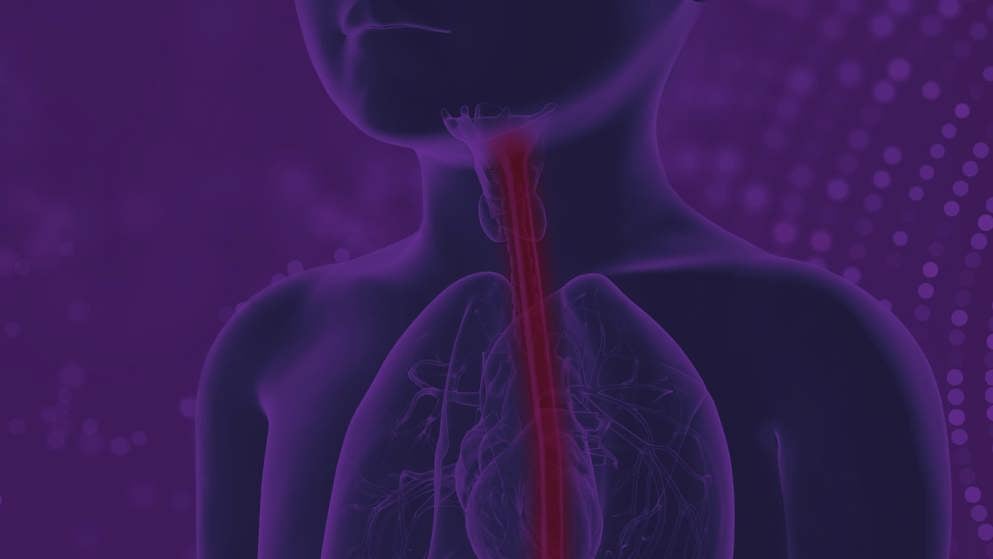
Eosinophilic oesophagitis
What are eosinophilic oesophagitis and other eosinophilic gastrointestinal diseases?
Eosinophilic gastrointestinal diseases (EGIDs) are chronic, inflammatory gut conditions including eosinophilic oesophagitis (EoE), gastritis (EoG), duodenitis (EoD), gastroenteritis (EoGE) and colitis (EoC)1. EoE is the most common EGID and is a chronic, antigen-driven disease caused by a T helper type 2 (Th2) inflammatory response to food allergens or aeroallergens in contact with the oesophagus2. It is characterised clinically by oesophageal dysfunction and histologically by eosinophilic infiltration in the oesophagus3. The incidence of EoE is approximately 20 in 100,000 people, and it has a prevalence of 1 in 1,000 people in Western nations1. EoE affects people of all ethnicities and age groups but is more prevalent in males than females4. EoE can cause irreversible damage to the oesophagus if left untreated or if a diagnosis is delayed5. Proton pump inhibitor-responsive oesophageal eosinophilia (PPI-REE) has very similar clinical and histological features to EoE, but patients gain complete remission after treatment with proton pump inhibitors (PPIs)6. The similarities between the two conditions have led to some suggesting PPI-REE is a subtype of EoE6.
Unmet needs in eosinophilic oesophagitis
Early diagnosis and treatment of EoE are essential for preventing the development of chronic inflammation, which can lead to irreversible structural damage to the oesophagus. However, diagnosis of EoE can often be missed or delayed for several years as young children usually present with non-specific symptoms, while older children and adults develop coping mechanisms that mask EoE symptoms3,7. At present, EoE diagnosis relies on upper endoscopy and biopsy8; minimally invasive, office-based tests are in development but have not as yet been adequately validated2,9. There is no cure for EoE, and people with EoE require lifelong dietary and pharmacological intervention to manage symptoms and prevent EoE disease progression. Although the elemental diet is successful in many patients, it has numerous disadvantages, such as avoiding all table food, high cost and social limitations10. A step-up approach to diet (using two-, four- and six-food elimination diets) is the preferred dietary treatment for EoE, found to be effective in 79% of people with EoE10. Patients with severe oesophageal narrowing may require invasive endoscopic dilation to relieve EoE symptoms. Further, currently available EoE treatment options are non-specific anti-inflammatory steroids and PPIs10,11.
New developments for the treatment of eosinophilic oesophagitis and related conditions
Several studies evaluating monoclonal antibodies and corticosteroids are ongoing12. For EoG, EoD and EoGE, most trials (71.5%) are investigating monoclonal antibodies1. A better understanding of the pathophysiology of EoE has led to identification of several potential treatment targets for EoE, including interleukin (IL)-4, IL-5, IL-13, IL-15 and Siglec-81. These agents have a key role in type 2 inflammation and subsequent development of EoE13. Recent approvals are transforming the treatment armamentarium for people with EoE14,15.
of interest
are looking at
saved
next event
Related news and insights
Related Guidelines
References
- Visaggi P, Ghisa M, Barberio B, Maniero D, Greco E, Savarino V, et al. Treatment Trends for Eosinophilic Esophagitis and the Other Eosinophilic Gastrointestinal Diseases: Systematic Review of Clinical Trials. Dig Liver Dis. 2023;55(2):208-222.
- Straumann A, Katzka DA. Diagnosis and Treatment of Eosinophilic Esophagitis. Gastroenterology. 2018;154(2):346-359.
- Reed CC, Dellon ES. Eosinophilic Esophagitis. Medical Clinics of North America. 2019;103(1):29-42.
- Dellon ES, Hirano I. Epidemiology and Natural History of Eosinophilic Esophagitis. Gastroenterology. 2018;154(2):319-332.e313.
- Biedermann L, Straumann A, Greuter T, Schreiner P. Eosinophilic esophagitis—established facts and new horizons. Seminars in Immunopathology. 2021;43(3):319-335.
- Eluri S, Dellon ES. Proton pump inhibitor-responsive oesophageal eosinophilia and eosinophilic oesophagitis. Current Opinion in Gastroenterology. 2015;31(4):309-315.
- Pokrzywinski RM, Harding G, Brooks A, Goodwin B, Williams J. Documenting the Journey of Patients with Eosinophilic Esophagitis and the Impact of the Disease on Patients and their Caregivers: A Cross-sectional, Qualitative Research Study. Advances in Therapy. 2020;37(10):4458-4478.
- Dellon ES, Liacouras CA, Molina-Infante J, Furuta GT, Spergel JM, Zevit N, et al. Updated International Consensus Diagnostic Criteria for Eosinophilic Esophagitis: Proceedings of the AGREE Conference. Gastroenterology. 2018;155(4):1022-1033.e1010.
- Kumar S, Choi SS, Gupta SK. Eosinophilic esophagitis: current status and future directions. Pediatric Research. 2020;88(3):345-347.
- Surdea-Blaga T, Popovici E, Fadgyas Stănculete M, Dumitrascu DL, Scarpignato C. Eosinophilic Esophagitis: Diagnosis and Current Management. Journal of Gastrointestinal and Liver Diseases. 2020;29(1):85-97.
- Beveridge C, Falk GW. Novel Therapeutic Approaches to Eosinophilic Esophagitis. Gastroenterology and Hepatology. 2020;16(6):294-301.
- Nhu QM, Aceves SS. Current state of biologics in treating eosinophilic esophagitis. Annals of Allergy, Asthma & Immunology. 2023;130(1):15-20.
- Davis BP, Rothenberg ME. Mechanisms of Disease of Eosinophilic Esophagitis. Annual Review of Pathology: Mechanisms of Disease. 2016;11:365-393.
- Dupixent Approved for Pediatric Eosinophilic Esophagitis. https://www.empr.com/home/news/dupixent-approved-for-pediatric-eosinophilic-esophagitis/. Accessed 30 January.
- Takeda, 2024. FDA Approves Takeda’s EOHILIA (budesonide oral suspension), the First and Only Oral Treatment in the U.S. for Eosinophilic Esophagitis (EoE) [press release]. Available at: https://www.takeda.com/newsroom/newsreleases/2024/fda-approves-eohilia/.


